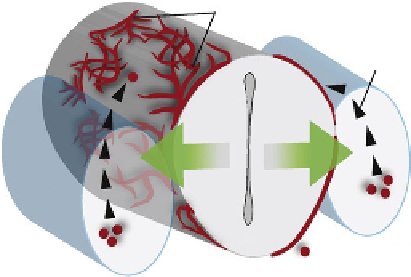Biology Reference
In-Depth Information
PNVP
Angioblast / EC
recruitment
PSM
NT
= Angioblast or EC
PNVP development and patterning (E8.5-E10.0)
Figure 3.32
Model of PNVP recruitment in mice. At E8.5, angioblasts and ECs from the
PSM respond to positive vessel patterning signals secreted from neural cells (green arrows) by
differentiating, proliferating, and migrating to the surface of the neural tube. They surround
the neural tube, forming a blood vessel plexus.
Abbreviations
: EC, endothelial cells; NT,
neural tube; PNVP, perineural vessel plexus; PSM, presomitic mesoderm; E, embryonic day.
Source
: From
James and Mukouyama (2011)
.
2011; James et al., 2009
). The development of the vasculature around and within the
neural tube is itself regulated by the endogenous release of VEGF-A in the neural
tube (
James et al., 2009
). VEGF-A acts as a substitute for the neural tube in experi-
ments (Hogan et al., 2004). The role of the neural tube as a vascular signaling center
during the formation of the PNVP from the presomitic mesoderm is illustrated in
Figure 3.32
.
Formation of the Gastrointestinal Tract
The control and regulation of development of the gastrointestinal tract is complex
and related not only to the tract itself, but also to the development of other organs,
such as the liver, pancreas, and lungs. I will restrict this discussion to a brief outline
of the development of the digestive tract of the worm
C. elegans
. This is not just
because the development of the intestinal tract of this worm is better known than that
of any other organism, although that is true. Most important, however, this worm's
case illustrates best the early epigenetic determination of the gastrointestinal tract by
maternal cytoplasmic factors.
The sperm's entry into the worm oocyte induces the polarization of the zygote.
This and the high asymmetry of the first division lead to the formation of two cells
that are very different in size and content of maternal cytoplasmic factors. These
are the anterior AB-cell and the posterior P1 cell (
Figure 3.33
). The latter's division

Search WWH ::

Custom Search